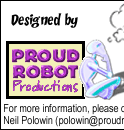Okay, these are kind of obvious jokes, but you've got to give Fred major points for the delivery.
Besides, it lets me segue neatly into a rant about advertising, namely two words that strike terror into the hearts of consumer advocates everywhere: 'product placement'.
Just check out that Target logo on the shirt…what, you didn't watch Survivor this summer?
I know, I know, Fred never received a treasure chest full of linens and toilet paper in exchange for painting those concentric circles on Christopher Chance's mock turtleneck, but I'm trying to make a point here.
For those of you new to the concept, product placement involves embedding assorted brand name products into other vehicles, most notably television and movies (although ad banners on the web might qualify, too). All of those racing patches that Tom Cruise wore in Days of Thunder? Product placement. Sandman posters in Darlene's bedroom on Roseanne? Product placement. The Verizon payphone in last week's season premiere of The West Wing? Product placement. Okay, that last was kind of a mistake, since the scene in question was a flashback from five years before Verizon had even been incorporated. But I digress (with apologies to PAD for the appropriation of his trademark catchphrase).
And those are the innocuous examples.
It used to be that product placement was limited to background stuff and assorted props. Sadly, in that ever present drive to latch onto marketing dollars, the products are receiving greater prominence, and in some cases, are deliberately referred to in the script. Case in point: one episode of Beverly Hills, 90210 featured Brandon waving a Blockbuster video rental in front of his friends. (Yes, I know Blockbluster, Viacom, and Aaron Spelling Productions are all in bed together in some kind of unholy triumvirate, but that really doesn't mitigate the situation.)
Until fairly recently, the comic book industry had largely been insulated from product placement deals. The brand names of the stuff characters used was never specifically identified. Everything was more or less generic, apart from exceptions resulting from the collective impulses of pencillers and inkers.
Hmmm. All of a sudden I'm wondering whether inker Terry Austin's renowned penchant for drawing Popeye into the pages he works on might be the result of some kind of secret deal with King Features...
That golden age of marketing innocence in comics ended earlier this year, when the Nautica clothing line worked out a deal with DC to insinuate company logos and styles directly into the story artwork of the Flash spin-off series Impulse. To be fair, I haven't seen a copy of the issue myself, so I can't judge the relative intrusiveness of the placement for myself.
Even if the placement was fairly benign, and didn't distract from the story, it still places comic books on the edge of a slippery slope. Please understand, I began reading comics back in the heyday of the Hostess ads, which featured DC super-heroes thwarting villains intent on stealing assorted cupcakes and fruit-filled pastries. Those were all one-page, self-contained ads, though, with no connection to or bearing on the published stories, and that distinction was important. It allowed us - mentally - to shuffle the characterizations shown in those ads to some other Earth in the DC Multiverse, and not fret over the dissonance between those portrayals and the likes of Denny O'Neil's and Neal Adams' grim-and-gritty Batman stories.
Whether you call it 'Earth Sell-Out', or just 'Earth-Twinkie', for lack of a better name, it's just about the only place you could approach Wonder Woman and say, "Hey! Nice cupcakes!", without her tying her golden lariat to your nether regions and using you for bolo practice.
What's next, now that the doors have been opened? Hard to say. I suspect that DC and Nautica are in the middle of discussions as to whether the stunt had any real marketing impact in either direction, apart from the PR splash that accompanied the first bit of negotiated product placement in comics.
If the campaign proves to have been successful in light of their marketing goals, we can count on seeing more in the way of such activities. In that event, all we can do is ask the publishers to be mindful of the potential impact of product placement on the flow of a story. Comic books - particularly of the super-hero variety - depend so much on the suspension of disbelief. As we all know, blatant, intrusive advertising within the story can bring that suspension to a screeching halt. Just be careful, okay? That's all we ask.
Oh, yeah, the heroes of the strips. Almost forgot.
Green Arrow: Millionaire playboy Oliver Queen falls overboard, washes up on a desert island, masters archery in order to catch food, and then captures a band of crooks using the island as a hideaway, with nary a Jeff Probst or CBS camera crew in site. Returns to civilization to take up double life as a financial whiz and super-hero via an assortment of arrow-related gimmickry.
The Human Target: I confess - this has always been a favorite, but, then again, I've always been a sucker for Dick Giordano's artwork. The Human Target, a.k.a. Christopher Chance, made a career out of impersonating people who have been marked for murder, serving himself up as bait to flush out the killers. Very nifty concept, so long as you ignore all thoughts of the really lame television adaptation. I mean, really - Rick Springfield? I kept expecting him to break into 'Jesse's Girl'. Next thing you know, you'll see a Nick Fury adaptation starring David Hasselhoff...
Superman: Aw, you all know who he is.
- NP











